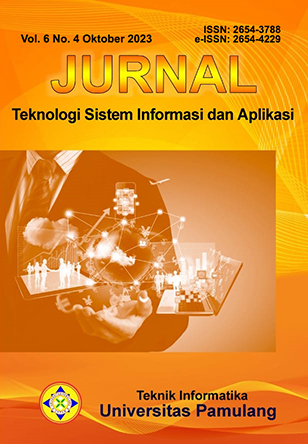Penerapan Metode Naïve Bayes dan Weighted Product untuk Prediksi Lanjut Studi Peserta Didik
Keywords:
Prediksi, Yayasan Pendidikan, Naïve Bayes, Weighted Product, Confusion Matrix.Abstract
The low interest of students at the Hidayaturrohman Teluknaga Foundation to continue their education from MTs Hidayaturrohman to Hiro High School makes it necessary to look for the factors causing this lack of interest. This study aims to combine the application of advanced study predictions of students using the naïve Bayes method and the application of ranking with the weighted product method. The data for this research object are graduates of MTs Hidayaturohman in 2022. The research sample is 322 data. The data collection method is in the form of secondary data, namely students graduating from MTs Hidayaturrohman in 2022. The attributes used to assess factors for graduates of MTs Hidayaturrohman to continue their studies at Hiro High School consist of 5 attributes, namely hobbies, modes of transportation, parents' income, distance from home to school and school test scores. In the study, 322 data were divided by 85% (273 data) for training data and 15% (49 data) for testing data. The results showed that the Naïve Bayes method could be applied in predicting the further study of students from MTs Hidayaturrohman to Hiro High School. This is evidenced by the accuracy test using the confusion matrix with an accuracy value of 71%. Where from 49 testing data it is predicted that 34 data with advanced results and 15 data with moving results. Furthermore, data ranking using a weighted product was carried out on 316 data, where 50% of the data (158 data) with the highest vector value v entered advanced ranking and the rest entered moving ranking. The 50% figure is in accordance with the expectations of Hiro High School, namely that as many as 50% of MTs Hidayaturrohman graduates continue on to Hiro High School. Then the highest vector v value is 0.005945284 for parent number 19207207 and the lowest vector v value is 0.001552376 for parent number 19207219.
References
Alfi Novia Zahrotul Hidayah, A. F. R. (2021). Penerapan Data Mining Dalam Menentukan Kinerja Karyawan Terbaik Dengan Menggunakan Metode Algoritma C4.5 ( Studi Kasus : Universitas Mercu Buana Yogyakarta ). Journal Of Information System And Artificial Intelligence, 1(2), 73–80.
Aspiah, R., & Taghfirul Azhima Yoga Siswa. (2022). Implementasi Correlation Based Feature Selection (Cfs) Untuk Peningkatan Akurasi Algoritma C4.5 Dalam Prediksi Performa Akademik Mahasiswa Berbasis Learning Management System. Jurnal Ilmiah Betrik, 13(2), 199–207. https://doi.org/10.36050/betrik.v13i2.523
Kartika, J. I., Santoso, E., & Sutrisno. (2017). Penentuan Siswa Berprestasi Menggunakan Metode K-Nearest Neighbor dan Weighted Product (Studi Kasus: SMP Negeri 3 Mejayan). Jurnal Pengembangan Teknologi Informasi Dan Ilmu Komputer, 1(5), 352–360.
Kurniawan, D. (2020). Pengenalan Machine Learning dengan Python Solusi untuk Permasalahan Big Data.
Maricar, M. A., & Dian Pramana. (2019). Perbandingan Akurasi Naïve Bayes dan K-Nearest Neighbor pada Klasifikasi untuk Meramalkan Status Pekerjaan Alumni ITB STIKOM Bali. Jurnal Sistem Dan Informatika (JSI), 14(1), 16–22.
https://doi.org/10.30864/jsi.v14i1.233
Sahadi, S., Ardhiansyah, M., & Husain, T. (2020). Sistem Pendukung Keputusan Pemilihan Siswa/i Kelas Unggulan Menggunakan Metode AHP dan TOPSIS. Jurnal Teknologi Sistem Informasi, 1(2), 153–167. https://doi.org/10.35957/jtsi.v1i2.513
Wibowo, G. W. N. (2020). Prediksi Kelanjutan Studi Siswa Ke Perguruan Tinggi Dengan Naive Bayes. Jurnal DISPROTEK, 11(1), 41–46. https://doi.org/10.34001/jdpt.v11i1.1159
Downloads
Published
How to Cite
Issue
Section
License
Copyright (c) 2023 Muhammad Dahlan Kurnia, Tukiyat Tukiyat, Makhsun Makhsun

This work is licensed under a Creative Commons Attribution-NonCommercial 4.0 International License.
Authors who publish with this journal agree to the following terms:
- Authors retain copyright and grant the journal right of first publication with the work simultaneously licensed under a Creative Commons Attribution License that allows others to share the work with an acknowledgement of the work's authorship and initial publication in this journal.
- Authors are able to enter into separate, additional contractual arrangements for the non-exclusive distribution of the journal's published version of the work (e.g., post it to an institutional repository or publish it in a book), with an acknowledgement of its initial publication in this journal.
- Authors are permitted and encouraged to post their work online (e.g., in institutional repositories or on their website) prior to and during the submission process, as it can lead to productive exchanges, as well as earlier and greater citation of published work (See The Effect of Open Access).
Jurnal Teknologi Sistem Informasi dan Aplikasi have CC BY-NC or an equivalent license as the optimal license for the publication, distribution, use, and reuse of scholarly work.
In developing strategy and setting priorities, Jurnal Teknologi Sistem Informasi dan Aplikasi recognize that free access is better than priced access, libre access is better than free access, and libre under CC BY-NC or the equivalent is better than libre under more restrictive open licenses. We should achieve what we can when we can. We should not delay achieving free in order to achieve libre, and we should not stop with free when we can achieve libre.
This work is licensed under a Creative Commons Attribution-NonCommercial 4.0 International (CC BY-NC 4.0) License
YOU ARE FREE TO:
- Share - copy and redistribute the material in any medium or format
- Adapt - remix, transform, and build upon the material for any purpose, even commercially.
- The licensor cannot revoke these freedoms as long as you follow the license terms



_2020_-_7(2)_2024_-_Thumbnail.png)












